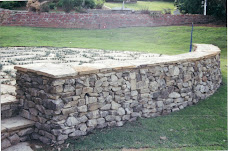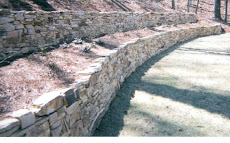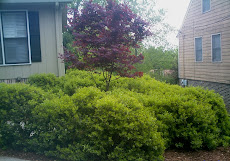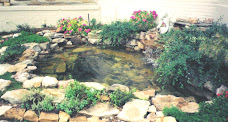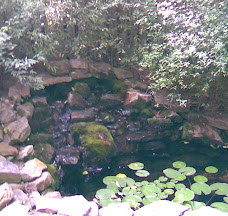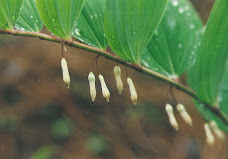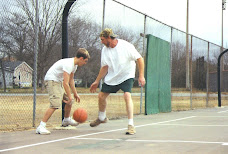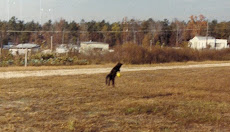A client of mine had a retaining wall built along the back of his house and he left a 5 or 6 foot wide hole in the wall for me to put a water feature in. Sorry about the video quality...I kind of just wanted to see if the video feature from my phone (I've only dropped my phone into a pond once, so far) could make it to my garden blog.
As for the noise at the end of the video clip...my wife, Donna asked, "is that your stomach?" No, it isn't! Ha Ha Ha!
Wednesday, June 25, 2008
Water through a wall
Posted by
themanfromearth
at
7:35 PM
0
comments
![]()
Labels: ponds, video clips
Friday, June 20, 2008
Purple Cone Power!
No, I meant to say power...the flower with power! The power to lure you closer for a look see; urging you to say out loud, "Wow! I love your purple coneflower!". Ooops, sorry I was getting a bit over dramatic, there. 
But indeed, purple coneflower (Echinacea purpurea) is an eye catcher, and on my scale of "easy-to-grow" perennials, purple cone flowers rate pretty high. They like full to part sun and a nice, well-drained soil. I really like the idea of working organic matter such as soil conditioner or even bagged top soil into the the area I'm planting purple coneflower to a depth of 12" (or more, if the soil is compacted). After they become established, purple cone flowers are pretty drought tolerant.
Once planted, dead heading the first batch of blooms, which first appear in mid-June to early July, will likely lead to some extra blooming later in the summer. If the situation is right, you'll find purple coneflower to reward you by spreading to form a nice colony of plants that will make a great show in your garden for years to come and also allow you to dig up some to move to another locale. By the way, purplecone flowers really attract butterflies!
Finally, extracts from Echinacea are said to provide valuable medicinal properties. All parts of the plant, including the roots, leaves, flowers, seeds, etc., have been used to treat a variety of ailments. It's a very popular plant amongst herbalists.
There are quite a few varieties of Echinacea purpurea that you may want to try:
'Magnus' purple cone flower (photo,right)
'Magnus' - 1998 Perennial Plant of the Year. Large, 6 inch rose-magenta flowers with petals that are more horizontal, rather than than the pendulous nature you see quite often in seedling purple coneflower.
'White Swan' - An Echinacea with white petals. I've found it just as easy to grow as the species and varieties such as Magnum.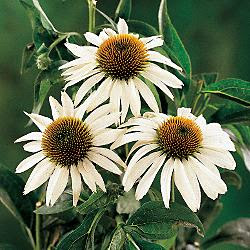
'White Swan' Coneflower (photo, right)
'Evan Saul' - A non-purple purple coneflower! This cone flower came from a nursery in Atlanta, GA, as a result of some cross pollination between E. purpurea and E. paradoxa. It is said to be a vigorous grower. I have not, as of yet, seen it available in our local nurseries.
'Evan Saul' Coneflower (photo, left)
Posted by
themanfromearth
at
7:05 AM
0
comments
![]()
Labels: perennials
Saturday, June 14, 2008
Five woody landscape plants to possibly avoid in your landscape
There are some woody landscape plants that enjoy popularity but probably should be given careful consideration to before planting them in your yard. My criteria for a plant making this list isn't so much about insect and disease vulnerability, although that may be part of it, but more about how attractive and reliable the plant is, long term, in your landscape. This is my opinion based on years of observation. It's certainly a subjective opinion and if you've got any of these plants in your yard and you love them....my apologies! My list of five are (in no particular order):
5. Any Japanese holly. Scientific name - Ilex crenata. Helleri holly and Compacta holly are two that are commonly sold in nurseries (there are many!) that I have seen more dead or dying than doing well. Be sure, when buying a small leaf holly that doesn't have thorns, to look and see what the scientific name is. If it begins with Ilex crenata, you're probably going to regret your purchase. I suspect that Japanese holly is simply a plant that requires excellent soil conditions coupled with a consistent watering regiment (something, especially given the periodic outdoor watering bans, that isn't likely to occur in most landscapes over the long haul), but numerous other problems, such as web blight, anthracnose and canker problems have been linked to Ilex crenata, as well. An excellent common landscape plant to use as a substitute for Helleri, Compacta, and other Japanese hollies is Dwarf youpon holly (Ilex vomitoria 'nana'). Ilex crenata 'Compacta'
Ilex crenata 'Compacta'
(photo left) Bradford Pear Damage (photo, right)
Bradford Pear Damage (photo, right)
4. Bradford Pear. Makes the list based on two main factors. One, it is overused in the Southeast. Two, it is a very weak wooded tree and with age, becomes as brittle and breakable. I remember taking a woody plant course at Auburn, back in the 70's, and this tree was touted as having ornamental pluses for all four seasons of the year. The tree hadn't been used nearly as much in the landscape back then as it has been in the last two decades and some of the pitfalls of having a Bradford in your yard weren't as publicized back then. More recently, its use has declined quite a bit. In fact, in some new residential developments, it is banned from being planted. Nandina domestica 'Firepower' (photo, left)
Nandina domestica 'Firepower' (photo, left)
3. Dwarf Nandina 'Firepower'. I'm not including some of the neat prostrate hybrids out there, like Harbour Dwarf and Harbour Belle, of which I have planted many times. I'm talking about the old mop head dwarf Nandina. This is the original dwarf nandina or very similar to a plant I remember being sold as Nandina domestica 'nana'. It was a top seller at most nurseries during the 70's, 80's and in the 90's. This plant may be more deserving than to end up on my list, but I have seen enough plantings (especially those all too common linear plantings), to at the very least, brand them as being a little hard to swallow. The mop head shape of the plant and the curling under of the leaves with odd coloration that might resemble a chemical burn are unusual and I've noticed that, if conditions aren't just right, these plants can become quite scraggly, showing more wood than foliage. I'd say there are very few situations in the landscape where this plant would be considered perfect.
2. Leylend Cypress. Overused! Grows larger than anticipated for the space they are often times planted in. Many of these plants have been cut down from the corners of two story homes (because they outgrew the home) and replaced with more moderately growing landscape plants, like Mary Nell Holly, Ocala Anise, or some of the Hinoki cypress varieties that are available. Also, Leylend Cypress has a major blight problem that has resulted in lots of these plants displaying huge sections of dead foliage on them all throughout the South. Leyland was flying out of nurseries like mad just a few short years ago, but now it only takes a drive around town to see that something has got a hold of this once proud plant and it won't let go. Leyland Cypress showing canker disease (photo, right)
Leyland Cypress showing canker disease (photo, right) American Boxwood in decline (photo, left)
American Boxwood in decline (photo, left)
1. American Boxwood. An icon amongst plants! A mainstay of the old Southern gardens! This plant makes my list because it is rare you see American Boxwood being all they can be. It is, after all, high maintenance. From the leaf minors to the Phytopthera root rot to the required meticulous pruning, American Boxwoods are almost behind the eight ball before the get out of the nursery. Now, if you are willing to do what it takes (keep the bugs and harmful fungus and bacteria away) and are aware that you will spend a good bit of time hand pruning this small leaf plant to ensure it's health, then you could be rewarded with a truly outstanding plant, but I'll just say, I haven't seen many old outstanding American Boxwoods in the Central Alabama area.
"American Boxwood: Once a mainstay of old Southern gardens" (photo, right) 
Posted by
themanfromearth
at
7:18 AM
1 comments
![]()
Labels: landscape tip
Sunday, June 8, 2008
The Father's Day Plant
Early on, I decided to honor my dad with a unique gift for Father's Day that had that "landscape dude" angle. There was no Father's Day plant that I knew of, so I invented one. Well, I didn't create a new plant in my basement with vials of bubbling brew. 
Bwah Ha Ha Ha Ha!!!!
I found a plant that was in bloom on Father's Day and renamed it "The Father's Day Plant". My biggest challenge was in finding a plant in bloom in mid-June that didn't already have a very recognizable common name. I wasn't going to rename daylily, crepe myrtle or rose. I mean, really...is a dainty pink rose an appropriate plant to call "The Father's Day Plant"? Not my pop! In the case of my dad, I could have renamed the Cast Iron Plant (Aspidistra elatior). After all, my dad is strong and solid as cast iron!
Just like my dad...The Cast Iron Plant (see photo, right)
In the end, I decided to rename a plant that doesn't have a real recognizable common name, the lilac chaste tree; scientific name, Vitex agnus-castus (this re-naming is really only legitimate in my own myopic world, of course, but I encourage you to use it, as well). I've planted a few for my dad over the years (just about one for every house he's lived in the past 25 years). 
The Father's Day Plant bloom is blue flower spikes (a white flowering variety is also available)(see photo, left).
I'm sure I'll be planting another for him, soon. I'm just waiting to make sure he isn't going to try to move from his current home within the next week or so. Just kidding, Dad!
Father's Day Plant - grown as a small tree (10'-15' by 8'-12'), typically multi-trunked. Zone 6 - 9.(photo right).
Happy Father's Day, Dad!!!!
Posted by
themanfromearth
at
1:56 AM
0
comments
![]()
Labels: deciduous landscape plants, Rob's musings, trees
Wednesday, June 4, 2008
Harmony Landscapes on Snowflake Hydrangea
Meet the king of the hydrangea hill, at least in the Southeast, Snowflake Hydrangea. One of our own, Eddie Aldridge, a well-known local nurseryman, is the responsible party for this awesome hydrangea. The most common story I've heard concerning the discovery of Snowflake hydrangea is that one of Eddie's friends found this unusual hydrangea growing behind a church and brought it to Eddie's attention. He went on to patent the plant and literally millions have been planted. One of these days, I'll give Eddie a call and ask him what the real story is. "My gosh, manfromearth! You used to work for the guy!" I know, I know...I will call him!
Anyway, back to the Snowflake. It's an awesome plant that should definitely have a place in your yard. Much like the Harmony hydrangea I mentioned in a previous blog, Snowflake tends to appreciate some shade and some sun, but not too much of either. Of course, it loves to be treated nicely with respect to soil conditions....a nice, composted soil environment with good drainage. Always remember to prune after they bloom, but before early to mid July. And don't forget, hydrangeas will really respond positively to a fall planting.
A few Snowflake hydrangeas I planted for some customers in Vestavia, AL
Posted by
themanfromearth
at
11:50 PM
0
comments
![]()
Labels: deciduous landscape plants





